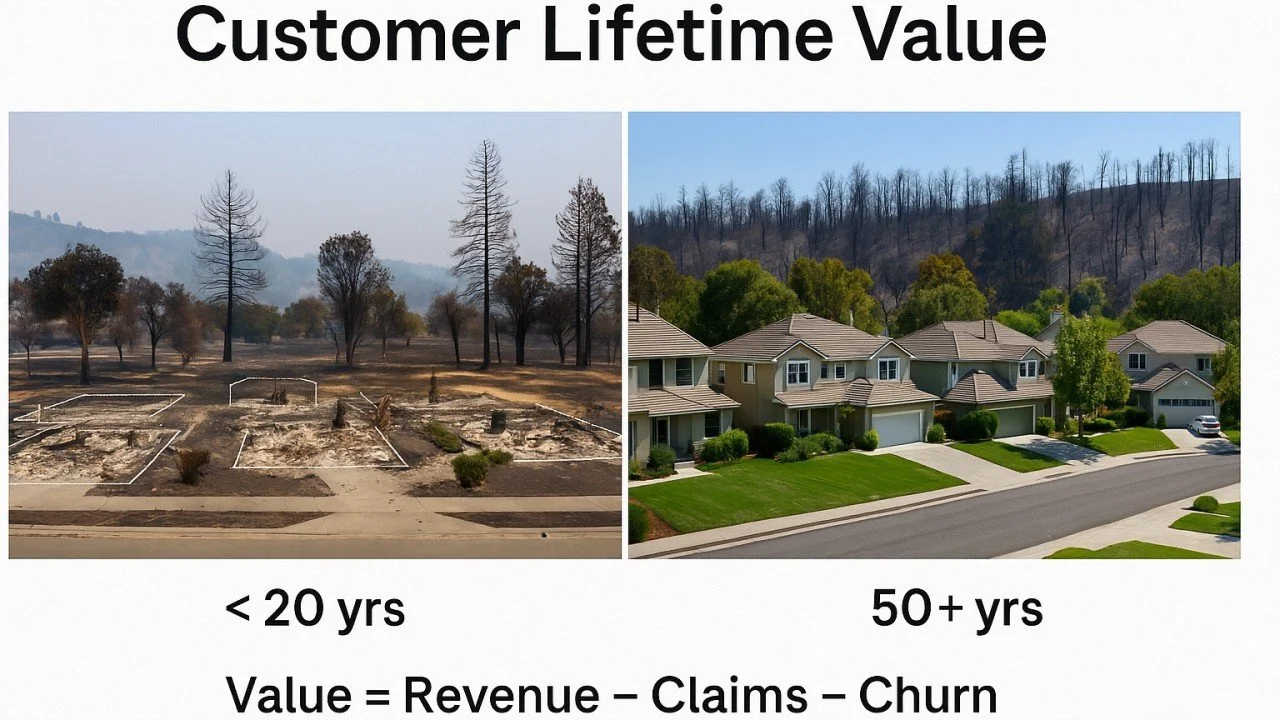Loss Claims vs. Revenue Capacity
Rethinking the Insurance Model for the Age of Fire
The Original Pact: Insurance as Protection, Not Payout
Before fire departments were municipalized, fire protection was private—and insurers played a central role. In 17th-century London, insurers paid to equip fire brigades and branded buildings with medallions that firefighters recognized. This was a model of collective pre-payment for shared protection, a primitive form of infrastructure investment.
Today, that legacy is mostly forgotten. Insurance is treated as a financial instrument—a post-event recovery mechanism. But the historical roots reveal an alternative path: insurance as a co-investor in community resilience.
The Fire Landscape Has Changed. The Risk Model Hasn’t.
Modern wildfires are fundamentally different. Once limited to remote forests, fires now sweep through suburbs and cities, fueled by drought, wind, and climate volatility. In just the past five years, insured losses have topped $120 billion in the U.S. alone.
Entire counties are now marked 'uninsurable,' forcing homeowners onto state-run insurance pools. Fire suppression costs have tripled. And rebuilding communities like Paradise or Lahaina takes not months—but years. Yet despite this, insurance remains reactive—stepping in after the damage is done, while the moment when it could have made a difference goes unfunded.
A Moment of Reckoning—and Opportunity
Insurers are now facing risks they can no longer price effectively. Communities are increasingly unprotected. And fire agencies are being asked to stretch limited resources across growing geographic and threat landscapes.
This is a moment of reckoning—but also a moment of reinvention. Just as telemedicine transformed healthcare access, FireTech is poised to transform readiness and response. What’s missing isn’t the technology. It’s the capital—and the coordination—to deploy it in time.
FireTech Is Ready
The past decade has brought a surge of innovation to firefighting. Helmet-mounted HUDs now allow interior crews to see and navigate through smoke. AI-driven platforms can anticipate wildfire ignition zones hours ahead of time. Deployable foggers and drones can create defensible zones in minutes. Sensor networks quietly monitor heat signatures before humans even notice danger.
These aren’t future concepts. They exist. They’ve been tested. And they’re affordable at regional scale. FireTech has matured. But adoption remains slow—not because of capability gaps, but funding inertia.
InsurTech Has Shown the Way
Other lines of insurance have already started moving upstream. State Farm’s Ting program funds in-home electrical sensors to detect pre-ignition anomalies. Nationwide sponsors water leak detectors to prevent major damage. Health insurers subsidize wearables to reduce claims from chronic illness.
Each of these examples proves the same principle: a small upfront investment in prevention pays off in lower claims and higher policyholder retention. But these programs have remained largely personal. The next evolution is communal—scaling that prevention logic to entire neighborhoods, regions, and ecosystems.
A New Operating Model: The Resilience Investment Portfolio
It’s time to stop treating fire protection as a reactive cost and start treating it as an investable service. Imagine a shared infrastructure model: insurers co-invest in a regional fire defense entity. That entity deploys FireTech, maintains trained response teams, and manages a dashboard of protective coverage across a high-risk area.
Communities pay a protection subscription—like a utility. In return, they receive verified coverage. Insurers benefit from reduced claims and a share of the protection fee annuity. This isn’t charity. It’s a flywheel: better readiness drives fewer losses, which drives stronger portfolios.
ESG Capital and the Fire Frontier
This model aligns perfectly with the rise of ESG—Environmental, Social, and Governance—capital. ESG investors seek measurable environmental and community impact, alongside returns. Fire resilience delivers both.
- Environmental: Reduced carbon and air pollution from megafires - Social: Maintained housing stability and community cohesion - Governance: Transparent, reportable outcomes from tech-enabled protection
For ESG funds, this is not just climate adaptation—it’s a defensible, data-backed asset class.
Market Size and Required Investment
The scale of the opportunity is staggering:
- Wildfire insurance premiums in high-risk zones exceed $15 billion annually. - Fire suppression spending at the state and federal level exceeds $5 billion. - Recovery and rebuilding costs range from $20–40 billion each year.
That’s a $50–60 billion annual fire economy—largely spent after damage occurs. If even a fraction of this were redirected upstream into prevention, we could stand up regional FireTech deployment units with strike teams, deployable tech, and dynamic dashboards.
Estimated seed funding per region? Just $25–50 million. Return potential? 5–10x via claims avoidance, portfolio stabilization, and protection subscriptions.
The Win-Win-Win
The resilience investment model isn’t just good policy—it’s good business. For every stakeholder, there’s clear value:
- Insurers preserve policies, avoid catastrophic claims, and participate in new recurring revenue. - Homeowners stay insured, stay protected, and recover faster. - Governments reduce reliance on emergency declarations and focus resources upstream. - Communities benefit from faster response and localized resilience. - Investors gain exposure to a climate-adaptive, ESG-aligned opportunity with measurable ROI.
This is systemic risk turned into systemic resilience.
Conclusion: From Pricing Risk to Owning Protection
Insurance was never meant to just price risk. It began as a shared commitment to protect. That original spirit must be reborn—not nostalgically, but structurally. We now have the tools, the capital, and the crisis to justify it.
The new fire economy will not be about who can afford the losses. It will be about who is prepared to prevent them.
Because in the end, the most valuable asset isn’t the land—it’s time. And the capacity to act in those critical minutes is an asset worth owning.
About the Author
Mike Ralston is a FireTech entrepreneur and strategic advisor who led FireTech innovation for nearly a decade at Qwake Technologies. A former Chief Experience Officer, co-founder, and firefighter, Mike has built partnerships across the public safety, insurance, and federal innovation sectors. He now advises on emerging technology, PPP strategy, and user-driven product innovation in the emergency response arena.

